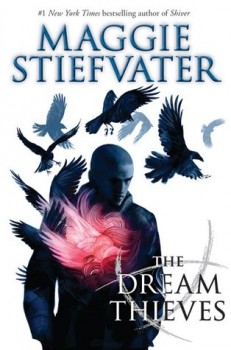In Maggie Stiefvater’s sequel to 2012’s The Raven Boys, the Cabeswater ley line has been awakened, but Blue, Gansey, Adam and Ronan are no closer to finding the lost Welsh king Glendower. In fact, things are more complicated than ever. Adam’s sacrifice Cabeswater seems to have worked, but he doesn’t know what the ley line wants with him, or how to hold up his part of the bargain. Blue and Gansey’s relationship is suddenly complicated by romance. And Ronan–angry, troubled, violent Ronan–travels deeper and deeper into his dreams, even while his dreams begin to intrude into his waking life. Meanwhile, dangerous people circle closer, bent on locating Glendower before they can. Ronan must find a way to channel his dreams for good, or else the ley line might disappear, ruining Gansey’s hopes of ever finding the lost king.
I’ve read and reviewed several of Stiefvater’s novels, and I have liked each better than the last. The Dream Thieves surpassed my expectations in nearly every way. The novel is haunting, beautiful and unsettling and delicious, the kind of book that gets under your skin so much that you think about it for days after you’ve finished the last page. As Stiefvater grows as an author, her writing becomes more abstract, relying on simple images to convey complex ideas, and vice versa. Her imagery is incredible. It speaks for itself: here, Stiefvater describes a political gala attended by Gansey and Adam:
The party had become a devil’s feast: will-o’-the-wisps caught in brass hunting lamps, impossibly bright meats presented on ivy-filigreed platters, men in black, women jeweled in green and red. The painted trees of the ceiling bent low overhead. Adam was wired and exhausted, here and somewhere else. Nothing was real but him and Gansey.
Stiefvater’s character development is also phenomenal. Where many writers stumble over multiple perspectives, Stiefvater excels–each of her characters is layered and complex, with credible backstories and rich emotional landscapes. While The Raven Boys focused mostly on Gansey and Blue, The Dream Thieves mainly centers around Ronan and his troubled history with his family. As an anti-hero, Ronan is deftly drawn, his anti-social behavior and rough exterior in perfect contrast to Gansey’s polished, honest demeanor. And Stiefvater even adds another layer in the form of Ronan’s complicated dreamscapes, where he draws inspiration, and perhaps, something more solid.
This novel is yet another jewel in Maggie Stiefvater’s crown. I was stunned by her mastery of imagery, description, character development, and even conceptual flow. I look forward to reading more of her work, and hope she continues to expand and grow as one of the young adult genre’s most exceptional authors.

0 Comments